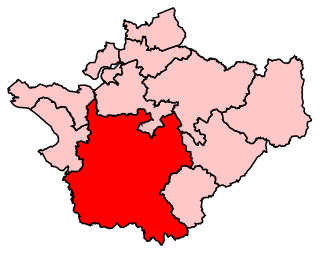Wednesbury was a borough constituency in England's Black Country which returned one Member of Parliament to the House of Commons of the Parliament of the United Kingdom from 1868 until it was abolished for the February 1974 general election.
The Eastbourne by-election, 1925 was a parliamentary by-election for the British House of Commons constituency of Eastbourne, Sussex on 17 June 1925.
The Galloway by-election, 1925 was a by-election held for the British House of Commons constituency of Galloway in Scotland on 17 November 1925. The by-election was won by the Unionist Party candidate Sidney Streatfeild.

The Westminster Abbey by-election, 1924 was a parliamentary by-election held on 19 March 1924 for the British House of Commons constituency of Westminster Abbey in London. It was notable for the challenge of Winston Churchill to the party system.
The Middlesbrough West by-election, 1928 was a parliamentary by-election held for the British House of Commons constituency of Middlesbrough West on 7 March 1928.
The St Albans by-election of 1919 was a parliamentary by-election held in England in December 1919 for the House of Commons constituency of St Albans in Hertfordshire.
This was a parliamentary by-election for the British House of Commons constituency of Stourbridge. Stourbridge was one of the Worcestershire constituencies, bordering Bewdley, where the Conservative Prime Minister, Stanley Baldwin sat.
This was a parliamentary by-election for the British House of Commons constituency of Leith
The Tavistock by-election, 1929 was a parliamentary by-election for the British House of Commons constituency of Tavistock on 11 October 1928.
The Shipley by-election was a parliamentary by-election for the British House of Commons constituency of Shipley on 6 November 1930.
The Yeovil by-election, 1923 was a parliamentary by-election for the British House of Commons constituency of Yeovil on 30 October 1923.
The Howdenshire by-election, 1926 was a parliamentary by-election for the British House of Commons constituency of Howdenshire in Yorkshire on 25 November 1926.
The Liverpool East Toxteth by-election, 1929 was a parliamentary by-election for the British House of Commons constituency of Liverpool East Toxteth on 19 March 1929.
The Epsom by-election, 1928 was a parliamentary by-election for the British House of Commons constituency of Epsom, Surrey on 4 July 1928.
The Woodbridge by-election of 1920 was held on 28 July 1920. The by-election was held due to the resignation of the incumbent Coalition Unionist MP, Robert Francis Peel. It was won by the Coalition Unionist candidate Sir Arthur Churchman.

The Ilford by-election, 1928 was a parliamentary by-election for the British House of Commons constituency of Ilford, London on 23 February 1928.
The Canterbury by-election, 1927 was a parliamentary by-election for the British House of Commons constituency of Canterbury, Kent on 24 November 1927.

The 1923 Whitechapel and St Georges by-election was a parliamentary by-election for the British House of Commons constituency of Whitechapel and St Georges on 8 February 1923.
The North Cumberland by-election of 1926 was held on 17 September 1926. The by-election was held due to the succession to the peerage of the incumbent Conservative MP, Donald Howard. It was won by the Conservative candidate Fergus Graham.






